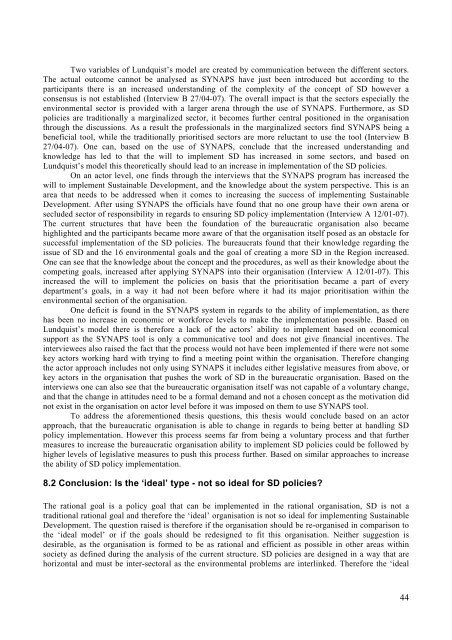From 'grey to green'- investigating the capabilities of the ... - lumes
From 'grey to green'- investigating the capabilities of the ... - lumes
From 'grey to green'- investigating the capabilities of the ... - lumes
You also want an ePaper? Increase the reach of your titles
YUMPU automatically turns print PDFs into web optimized ePapers that Google loves.
Two variables <strong>of</strong> Lundquist’s model are created by communication between <strong>the</strong> different sec<strong>to</strong>rs.The actual outcome cannot be analysed as SYNAPS have just been introduced but according <strong>to</strong> <strong>the</strong>participants <strong>the</strong>re is an increased understanding <strong>of</strong> <strong>the</strong> complexity <strong>of</strong> <strong>the</strong> concept <strong>of</strong> SD however aconsensus is not established (Interview B 27/04-07). The overall impact is that <strong>the</strong> sec<strong>to</strong>rs especially <strong>the</strong>environmental sec<strong>to</strong>r is provided with a larger arena through <strong>the</strong> use <strong>of</strong> SYNAPS. Fur<strong>the</strong>rmore, as SDpolicies are traditionally a marginalized sec<strong>to</strong>r, it becomes fur<strong>the</strong>r central positioned in <strong>the</strong> organisationthrough <strong>the</strong> discussions. As a result <strong>the</strong> pr<strong>of</strong>essionals in <strong>the</strong> marginalized sec<strong>to</strong>rs find SYNAPS being abeneficial <strong>to</strong>ol, while <strong>the</strong> traditionally prioritised sec<strong>to</strong>rs are more reluctant <strong>to</strong> use <strong>the</strong> <strong>to</strong>ol (Interview B27/04-07). One can, based on <strong>the</strong> use <strong>of</strong> SYNAPS, conclude that <strong>the</strong> increased understanding andknowledge has led <strong>to</strong> that <strong>the</strong> will <strong>to</strong> implement SD has increased in some sec<strong>to</strong>rs, and based onLundquist’s model this <strong>the</strong>oretically should lead <strong>to</strong> an increase in implementation <strong>of</strong> <strong>the</strong> SD policies.On an ac<strong>to</strong>r level, one finds through <strong>the</strong> interviews that <strong>the</strong> SYNAPS program has increased <strong>the</strong>will <strong>to</strong> implement Sustainable Development, and <strong>the</strong> knowledge about <strong>the</strong> system perspective. This is anarea that needs <strong>to</strong> be addressed when it comes <strong>to</strong> increasing <strong>the</strong> success <strong>of</strong> implementing SustainableDevelopment. After using SYNAPS <strong>the</strong> <strong>of</strong>ficials have found that no one group have <strong>the</strong>ir own arena orsecluded sec<strong>to</strong>r <strong>of</strong> responsibility in regards <strong>to</strong> ensuring SD policy implementation (Interview A 12/01-07).The current structures that have been <strong>the</strong> foundation <strong>of</strong> <strong>the</strong> bureaucratic organisation also becamehighlighted and <strong>the</strong> participants became more aware <strong>of</strong> that <strong>the</strong> organisation itself posed as an obstacle forsuccessful implementation <strong>of</strong> <strong>the</strong> SD policies. The bureaucrats found that <strong>the</strong>ir knowledge regarding <strong>the</strong>issue <strong>of</strong> SD and <strong>the</strong> 16 environmental goals and <strong>the</strong> goal <strong>of</strong> creating a more SD in <strong>the</strong> Region increased.One can see that <strong>the</strong> knowledge about <strong>the</strong> concept and <strong>the</strong> procedures, as well as <strong>the</strong>ir knowledge about <strong>the</strong>competing goals, increased after applying SYNAPS in<strong>to</strong> <strong>the</strong>ir organisation (Interview A 12/01-07). Thisincreased <strong>the</strong> will <strong>to</strong> implement <strong>the</strong> policies on basis that <strong>the</strong> prioritisation became a part <strong>of</strong> everydepartment’s goals, in a way it had not been before where it had its major prioritisation within <strong>the</strong>environmental section <strong>of</strong> <strong>the</strong> organisation.One deficit is found in <strong>the</strong> SYNAPS system in regards <strong>to</strong> <strong>the</strong> ability <strong>of</strong> implementation, as <strong>the</strong>rehas been no increase in economic or workforce levels <strong>to</strong> make <strong>the</strong> implementation possible. Based onLundquist’s model <strong>the</strong>re is <strong>the</strong>refore a lack <strong>of</strong> <strong>the</strong> ac<strong>to</strong>rs’ ability <strong>to</strong> implement based on economicalsupport as <strong>the</strong> SYNAPS <strong>to</strong>ol is only a communicative <strong>to</strong>ol and does not give financial incentives. Theinterviewees also raised <strong>the</strong> fact that <strong>the</strong> process would not have been implemented if <strong>the</strong>re were not somekey ac<strong>to</strong>rs working hard with trying <strong>to</strong> find a meeting point within <strong>the</strong> organisation. Therefore changing<strong>the</strong> ac<strong>to</strong>r approach includes not only using SYNAPS it includes ei<strong>the</strong>r legislative measures from above, orkey ac<strong>to</strong>rs in <strong>the</strong> organisation that pushes <strong>the</strong> work <strong>of</strong> SD in <strong>the</strong> bureaucratic organisation. Based on <strong>the</strong>interviews one can also see that <strong>the</strong> bureaucratic organisation itself was not capable <strong>of</strong> a voluntary change,and that <strong>the</strong> change in attitudes need <strong>to</strong> be a formal demand and not a chosen concept as <strong>the</strong> motivation didnot exist in <strong>the</strong> organisation on ac<strong>to</strong>r level before it was imposed on <strong>the</strong>m <strong>to</strong> use SYNAPS <strong>to</strong>ol.To address <strong>the</strong> aforementioned <strong>the</strong>sis questions, this <strong>the</strong>sis would conclude based on an ac<strong>to</strong>rapproach, that <strong>the</strong> bureaucratic organisation is able <strong>to</strong> change in regards <strong>to</strong> being better at handling SDpolicy implementation. However this process seems far from being a voluntary process and that fur<strong>the</strong>rmeasures <strong>to</strong> increase <strong>the</strong> bureaucratic organisation ability <strong>to</strong> implement SD policies could be followed byhigher levels <strong>of</strong> legislative measures <strong>to</strong> push this process fur<strong>the</strong>r. Based on similar approaches <strong>to</strong> increase<strong>the</strong> ability <strong>of</strong> SD policy implementation.8.2 Conclusion: Is <strong>the</strong> ‘ideal’ type - not so ideal for SD policies?The rational goal is a policy goal that can be implemented in <strong>the</strong> rational organisation, SD is not atraditional rational goal and <strong>the</strong>refore <strong>the</strong> ‘ideal’ organisation is not so ideal for implementing SustainableDevelopment. The question raised is <strong>the</strong>refore if <strong>the</strong> organisation should be re-organised in comparison <strong>to</strong><strong>the</strong> ‘ideal model’ or if <strong>the</strong> goals should be redesigned <strong>to</strong> fit this organisation. Nei<strong>the</strong>r suggestion isdesirable, as <strong>the</strong> organisation is formed <strong>to</strong> be as rational and efficient as possible in o<strong>the</strong>r areas withinsociety as defined during <strong>the</strong> analysis <strong>of</strong> <strong>the</strong> current structure. SD policies are designed in a way that arehorizontal and must be inter-sec<strong>to</strong>ral as <strong>the</strong> environmental problems are interlinked. Therefore <strong>the</strong> ‘ideal44
















